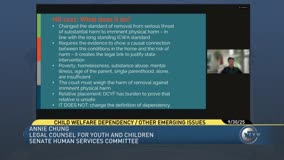Washington Child Welfare Law Raises Threshold for Removing Children Amid Opioid Crisis
September 30, 2025 | Legislative Sessions, Washington
This article was created by AI summarizing key points discussed. AI makes mistakes, so for full details and context, please refer to the video of the full meeting. Please report any errors so we can fix them. Report an error »

In a recent meeting of the Senate Human Services Committee, significant discussions centered around child welfare laws and their implications for families in Washington State. A key focus was the impact of recent legislative changes, particularly the law enacted on December 27, which raised the threshold for child removal from homes due to safety concerns.
The new law shifts the standard from a "serious threat of substantial harm" to "imminent physical harm," a change that advocates argue is necessary to protect children while also safeguarding parental rights. This adjustment requires the state to provide clear evidence linking home conditions to potential harm, ensuring that the power to remove children is exercised judiciously.
Committee members emphasized the importance of this law in light of the ongoing opioid crisis, particularly regarding the dangers posed by fentanyl. The legislation allows courts to consider the lethality of such substances when making decisions about child removal, highlighting the need for a nuanced approach to family safety.
Despite these changes, concerns were raised about the effectiveness of the law in practice. Reports indicated that only two critical incident cases had reached the courts in 2025, suggesting potential gaps in the system before cases are formally adjudicated. Advocates stressed the need for better communication and resources to ensure that families at risk receive the necessary support and intervention.
The meeting also touched on the role of judicial training in applying these laws effectively. The Administrative Office of the Courts has developed resources to assist judges in navigating the complexities of child welfare cases, aiming to enhance the judicial response to family safety issues.
As the committee continues to evaluate the impact of these legislative changes, the focus remains on ensuring that the welfare of children is prioritized while also respecting the rights of families. The discussions reflect a broader commitment to addressing the challenges posed by substance abuse and its effects on vulnerable populations in the community.
The new law shifts the standard from a "serious threat of substantial harm" to "imminent physical harm," a change that advocates argue is necessary to protect children while also safeguarding parental rights. This adjustment requires the state to provide clear evidence linking home conditions to potential harm, ensuring that the power to remove children is exercised judiciously.
Committee members emphasized the importance of this law in light of the ongoing opioid crisis, particularly regarding the dangers posed by fentanyl. The legislation allows courts to consider the lethality of such substances when making decisions about child removal, highlighting the need for a nuanced approach to family safety.
Despite these changes, concerns were raised about the effectiveness of the law in practice. Reports indicated that only two critical incident cases had reached the courts in 2025, suggesting potential gaps in the system before cases are formally adjudicated. Advocates stressed the need for better communication and resources to ensure that families at risk receive the necessary support and intervention.
The meeting also touched on the role of judicial training in applying these laws effectively. The Administrative Office of the Courts has developed resources to assist judges in navigating the complexities of child welfare cases, aiming to enhance the judicial response to family safety issues.
As the committee continues to evaluate the impact of these legislative changes, the focus remains on ensuring that the welfare of children is prioritized while also respecting the rights of families. The discussions reflect a broader commitment to addressing the challenges posed by substance abuse and its effects on vulnerable populations in the community.
View full meeting
This article is based on a recent meeting—watch the full video and explore the complete transcript for deeper insights into the discussion.
View full meeting
